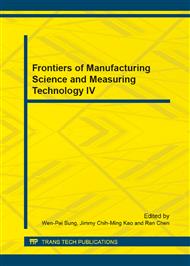p.555
p.560
p.564
p.568
p.574
p.581
p.587
p.591
p.595
Research on the Molding Condition of 3D Braided Nozzle Throat Fabric
Abstract:
3D braided fabric lining mandrel weaving, throat is the key part of nozzle which should meet the requirements of molding. This paper based on the research between geometry and knitting yarn array of 3D braided nozzle fabric, proposed the basic conditions which influence the molding performance of nozzle. Theoretical derivation the formula of reasonable yarn array and cross-section parameters of yarn. Verify its correctness by actual production of 3D braided nozzle fabric. The CT scan image and the moire pattern of fiber volume percentage showed that the throat size of fabric and roundness well matched with mandrel, fiber volume percentage changed uniform which satisfied the requirement of engineering application.
Info:
Periodical:
Pages:
574-580
Citation:
Online since:
August 2014
Authors:
Price:
Сopyright:
© 2014 Trans Tech Publications Ltd. All Rights Reserved
Share:
Citation:


